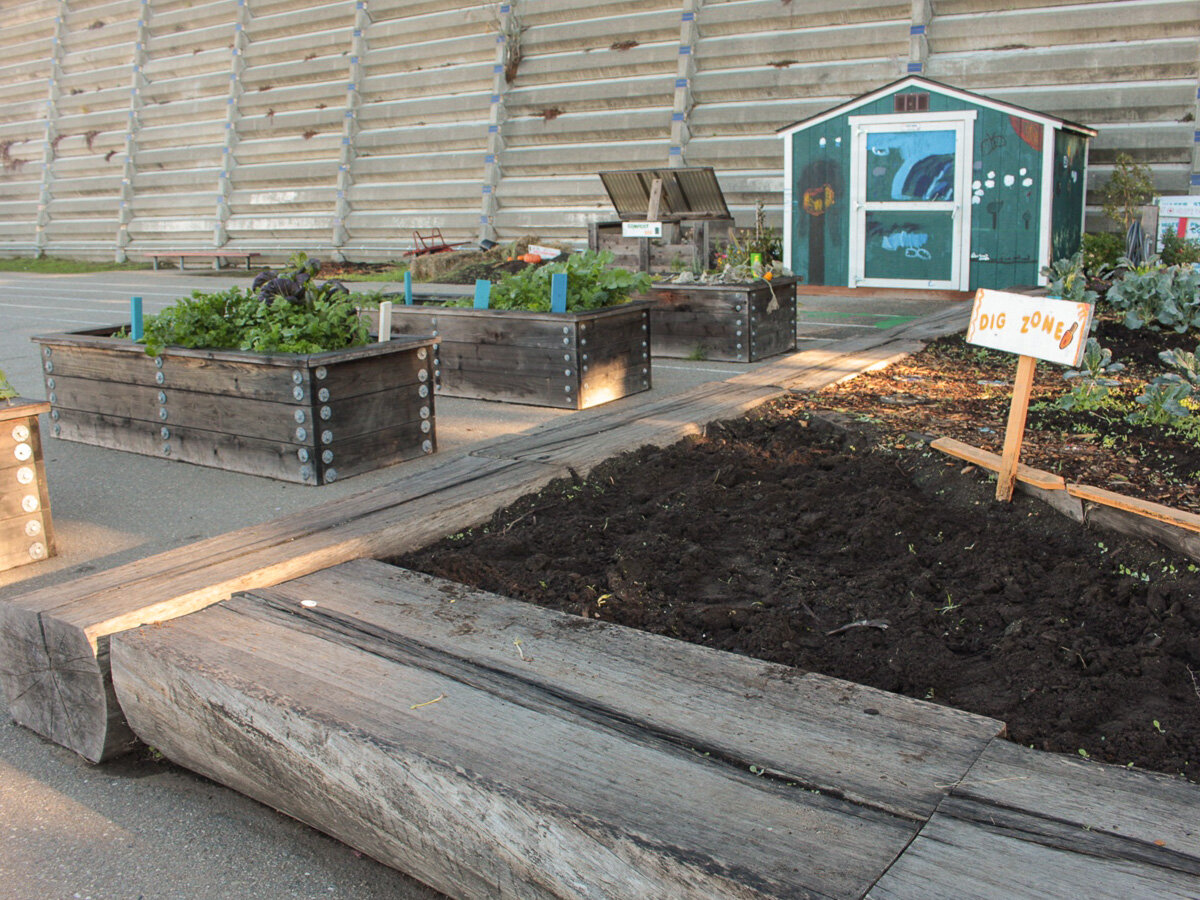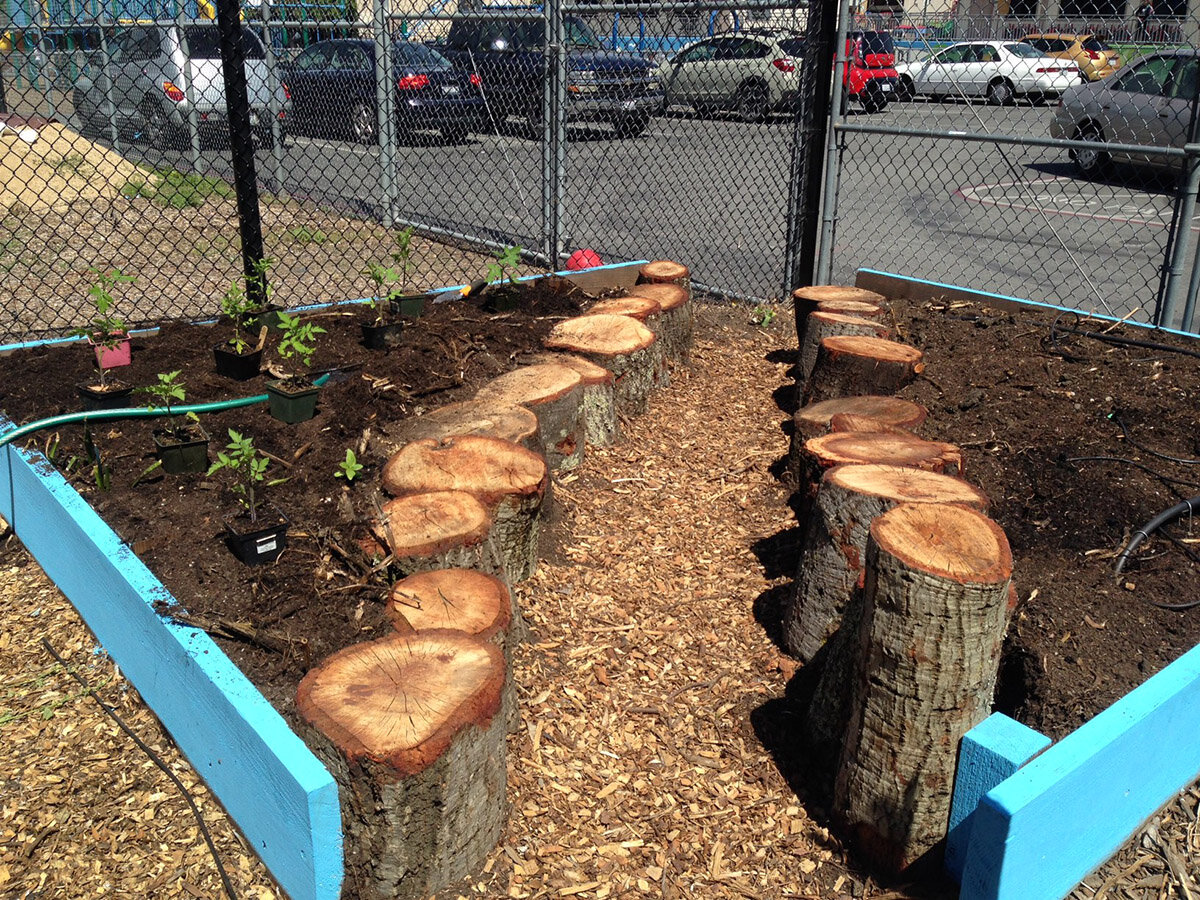Using Raised Beds on Paved Surfaces
Many urban gardens are built over concrete or asphalt in raised beds, planters or containers. As long as the right conditions exist, plants will thrive. In fact, growing on a paved schoolyard has some advantages to in-ground beds: fewer pests, a warmer microclimate in the winter, and less fuss about maintaining paths and keeping out weeds. Plants grown in containers need the same conditions as in-ground plants but are more vulnerable to wind, drought, and stray playground balls. It is important to plan for adequate soil depth in your containers, give them consistent watering, and monitor soil fertility. Be sure to mulch any bare soil. In addition, consider covering plants with row cover fabric when the weather is extremely cold or windy. If playground balls at your site are a threat, consider installing a fence or trellis for protection.
Raised beds offer your students a chance to get their hands in the dirt, grow edibles and ornamental plants, and create habitat for beneficial insects without investing in permanent infrastructure. They can work as screens or dividers between different areas; mitigate heat and wind; and bring life, color, and ever-changing interest to the schoolyard. In this article, we provide a list of potential container options to use as planters and key container garden considerations. For the purpose of this article, we use the terms “raised bed”, “planter”, and “container” synonymously. Our article on Making Paved Spaces Comfortable provides additional insight into creating a welcoming and joyful space for children.
GETTING STARTED
When building a container garden, survey local resources for planters, plants, and raised-bed soil to identify who is near you and willing to donate, transport, and install materials. Evaluate your space and determine the ideal size for your planting areas and the location of planters or raised beds. If possible, enlist the help of a volunteer designer. Think about how much sunlight is available and how the planting areas will be watered — and who will be watering them. Is there a water source nearby? Make sure there is buy-in from school faculty and staff so that planters will be used by students and maintained over time. Consider environmentally friendly planting techniques and always go organic to avoid exposure to harmful chemicals.
LOW-COST NON-PORTABLE BEDS
Raised beds. These can be made out of wood, stone, or cinder blocks. Line them with a permeable liner — such as a nonwoven, tough landscape fabric or geotextile — that will keep the soil from leaking out. Plan for a minimum of 10 inches of soil depth; 14 to 18 inches of soil depth is ideal. In order for students to be able to reach into the center of beds, they should be no wider than 3 feet. A simple wooden bed can be made using three 2 x 12 x 8-foot pieces and one 4 x 4 x 8-foot piece of untreated lumber. Cut one 2 x 12 piece into two 3-foot lengths; then cut four 11½-inch corner posts from the 4 x 4 piece. Assemble the planter box by screwing the corner posts on each short edge of the 3-foot lengths of the 2 x 12 piece; then stand all four sides up in place and secure the long sides to the attached corner posts. For a cinder block bed, stack blocks into the desired shape. The enclosed space can be filled with soil. The cinder block cavities can be planted individually.
Bag gardens. Use 40-pound bags of compost or topsoil, which can accommodate most vegetables and herbs. Punch a dozen holes in the bottom with a screwdriver and cut a rectangular window for planting in the top. One bag per student makes a personal edible garden.
Straw bale gardens. Minimal prepping with nitrogen-rich organic fertilizer for two weeks before planting seedlings, seeds, and tubers is all that is needed. The straw bale ultimately decomposes and becomes great compost — a fresh bale can go over the compost for another planting.
Livestock tanks. These metal planters can be big enough for a small tree. They are easy to set up as sub-irrigated planters with a reservoir at the bottom. Livestock tanks are durable and will last a long time.
Keyhole gardens. Six feet in diameter, these circular raised bed gardens stand waist-high and are notched to access the center, incorporating a 1-foot diameter compost basket in the center to moisten and nourish soil. Concrete blocks form the walls of the garden.
Hugelkultur mounds. Low mounds of organic materials (logs, branches) are filled with soil and built up to contain moisture and create a self-sustaining planting medium above ground level. To protect paving that the mound is built over, lay tarp or waterproof material, then a thick layer of cardboard or wood. Depending on the quality of the surface material, there will be staining and seepage over time. Hugel builds can be an across grade-level effort, with many lesson tie-ins to soil and soil building, carbon sequestration, water harvesting, and in-place composting.
LOW-COST PORTABLE BEDS
Five-gallon plastic buckets. Drill drainage holes about an inch or two from the ground so that the bottom holds some water. Large plastic storage totes work too; go for opaque ones to avoid the growth of algae, and drill holes for drainage.
Grow bags. These low-cost, permeable felt bags can be used for a number of types of plants depending on the size. Approach a nursery-supply wholesaler for bulk pricing or donations, if possible. Bags can be reused; they store easily and come in many sizes.
Sub-irrigated planters (SIPS). This planter box system uses a method of watering plants where the water is introduced from the bottom, allowing it to soak upwards to the plant through capillary action.
Milk crates. Lined with landscape fabric and filled with potting mix, milk crates can be configured into beds and moved around easily. Stack a filled crate on top of an empty one and fasten it with zip ties to bring them up to a comfortable working height.
Wood planter boxes on casters. Wooden fruit and vegetable crates are sized to be portable. Get them donated by grocers or build your own from cedar. Include handles and trays to collect extra water.
SEMI-PERMANENT BEDS
Beer-pallet planters. If you have access to a manual pallet jack (they are about $300 to buy), get heavy-duty recycled-plastic beer pallets donated by a local beer distributor. Build wooden planter boxes right on top of each pallet, line them with landscape fabric, and fill with potting mix. You will have long-lasting, free-draining planters that are about 3 feet by 4 feet and can be easily moved around with the pallet jack on paving. (Do not try this on soil!)
Animal watering tubs or troughs. These planters, with holes drilled in the bottom, are available in rural areas at feed stores or online. If ordering online, find a vendor who ships livestock tanks nested within each other to save on freight.
Vertical tower garden. There are several styles and types of vertical gardens that can be purchased or built. Engineered aeroponic systems are available that include a grow tower, grow lights, an aeration system, mineral supply, and more, and can be made to be portable.
PERMANENT BEDS FOR LONG TERM USE
Recycled plastic lumber beds. This material lasts forever and is very kid-friendly — smooth, temperature-neutral, no splinters, no sharp edges. There are heavy-duty kits available that use 2-inch thick plastic lumber; these are cost-effective and will not bow or bend if kept to a reasonable length.
Breaking up asphalt and remediating native soil for planting. In-ground beds offer a permanent softening of a paved surface and allow for more planting space and opportunity. Native plants support remediation of soil and additional amendments can be added to create an appropriate planting medium. Soil should be tested prior to amending and planting.
KEY THINGS TO KEEP IN MIND
Materials. Do not use pressure-treated lumber to build garden beds. The manufacturing process is highly polluting and the chemicals used can be toxic. Regular lumber will rot in about three to six years depending on your climate. You can prolong the life of the garden bed by lining it with a geotextile that provides some air circulation between the soil and the wood. Painting the wood helps somewhat, but the paint will eventually chip off and the wood will rot anyway.
Drainage. Make sure the existing schoolyard drains are functioning properly and design your garden so that the drains do not get clogged with soil and leaves. And, if possible, plan so that each planter drains into another one so that water is used onsite and runoff is minimized. For example, hang a planted basket over a planter or channel the water that drains from one planter into a second one.
Credits
This article was written by Jane Tesner Kleiner, RLA, nature+play designs; Tahereh Sheerazie, EnrichLA; and Mirem Villamil, Edible Schoolyard NYC.
National COVID-19 Outdoor Learning Initiative
The National COVID-19 Outdoor Learning Initiative supports schools and districts around the country in their efforts to reopen safely and equitably using outdoor spaces as strategic, cost-effective solutions to increase physical distancing capacity onsite and provide access to abundant fresh air. The Initiative seeks to equitably improve learning, mental and physical health, and happiness for children and adults using an affordable, time-tested outdoor approach to keeping schools open during a pandemic.















